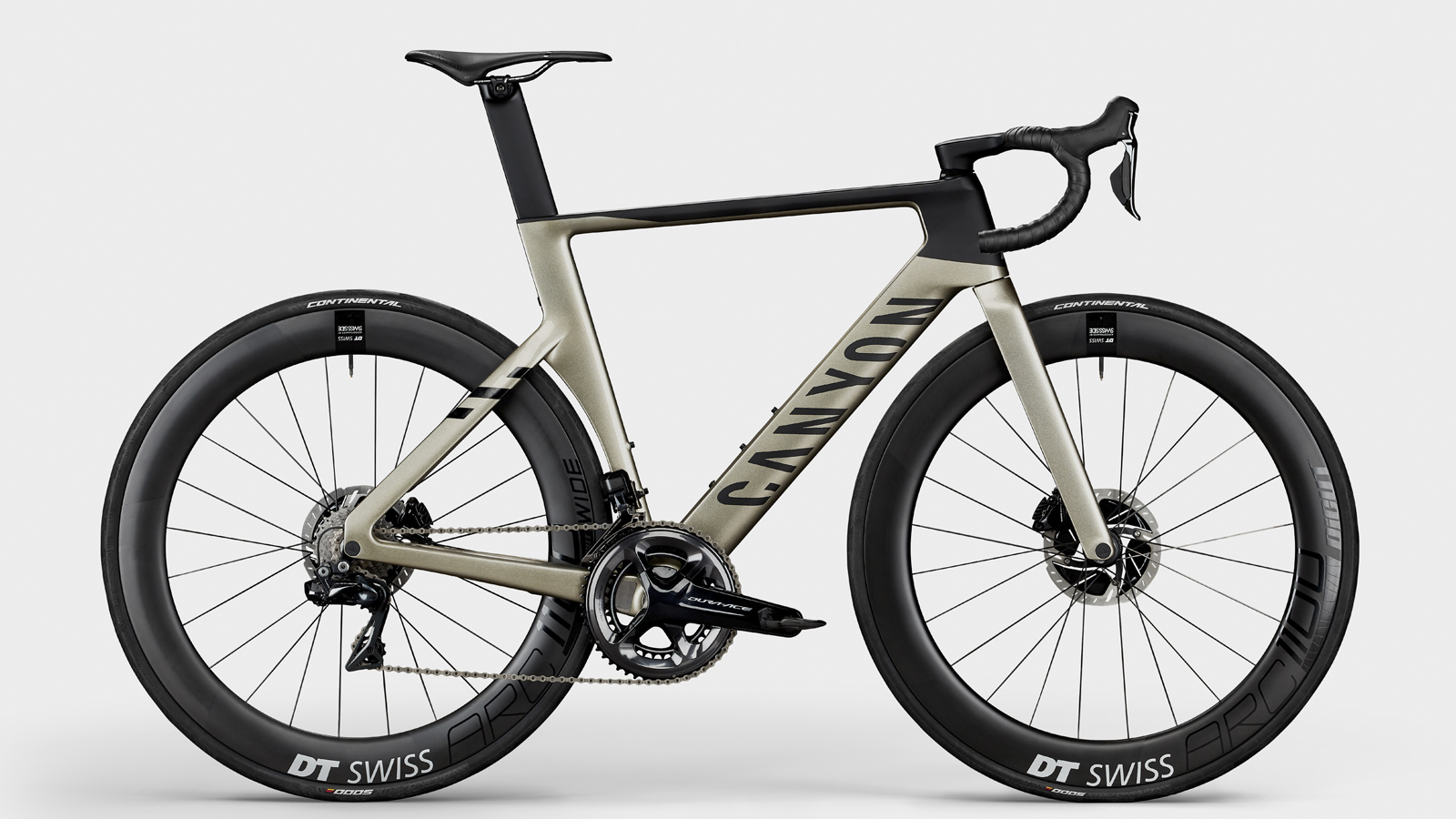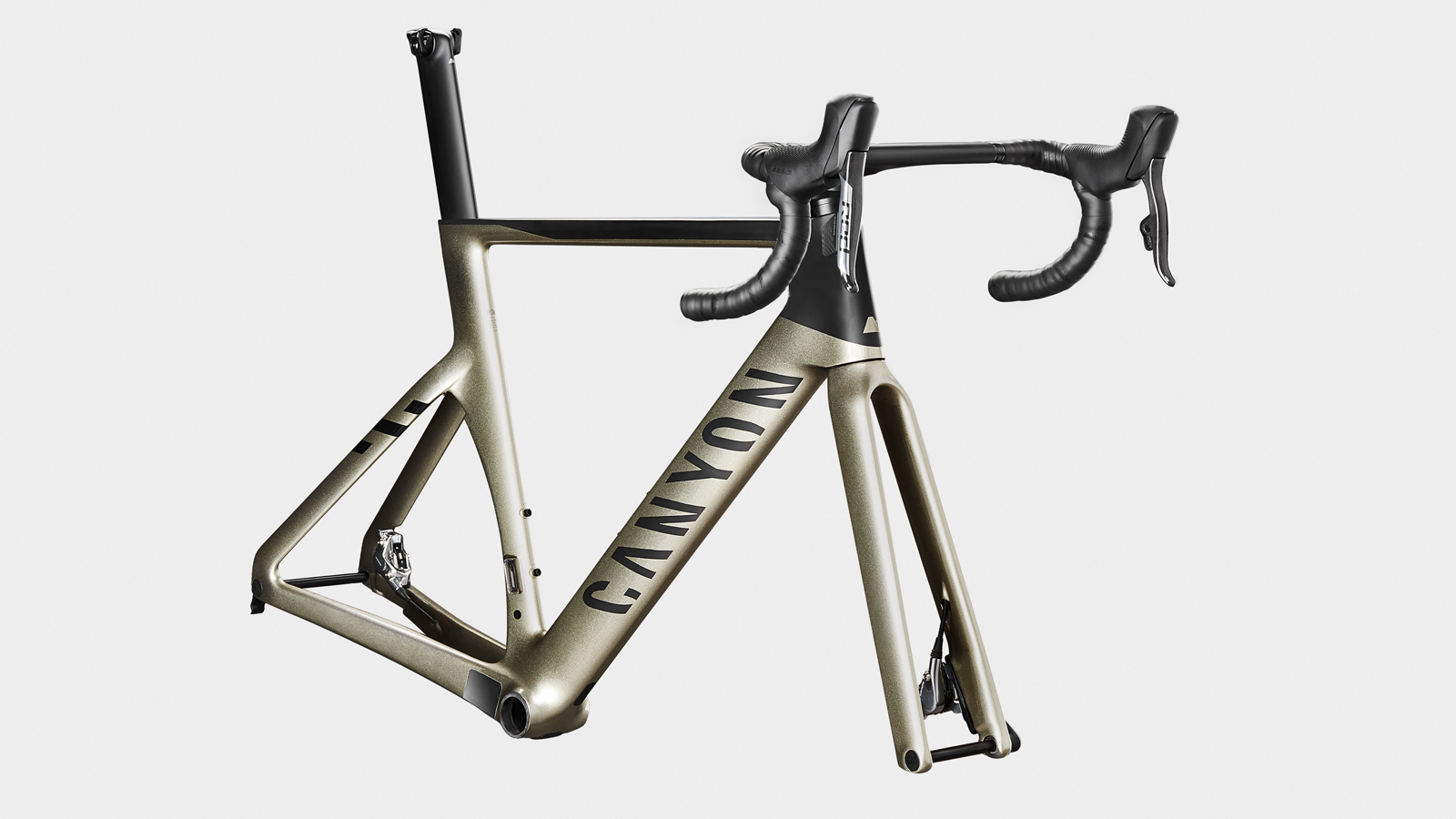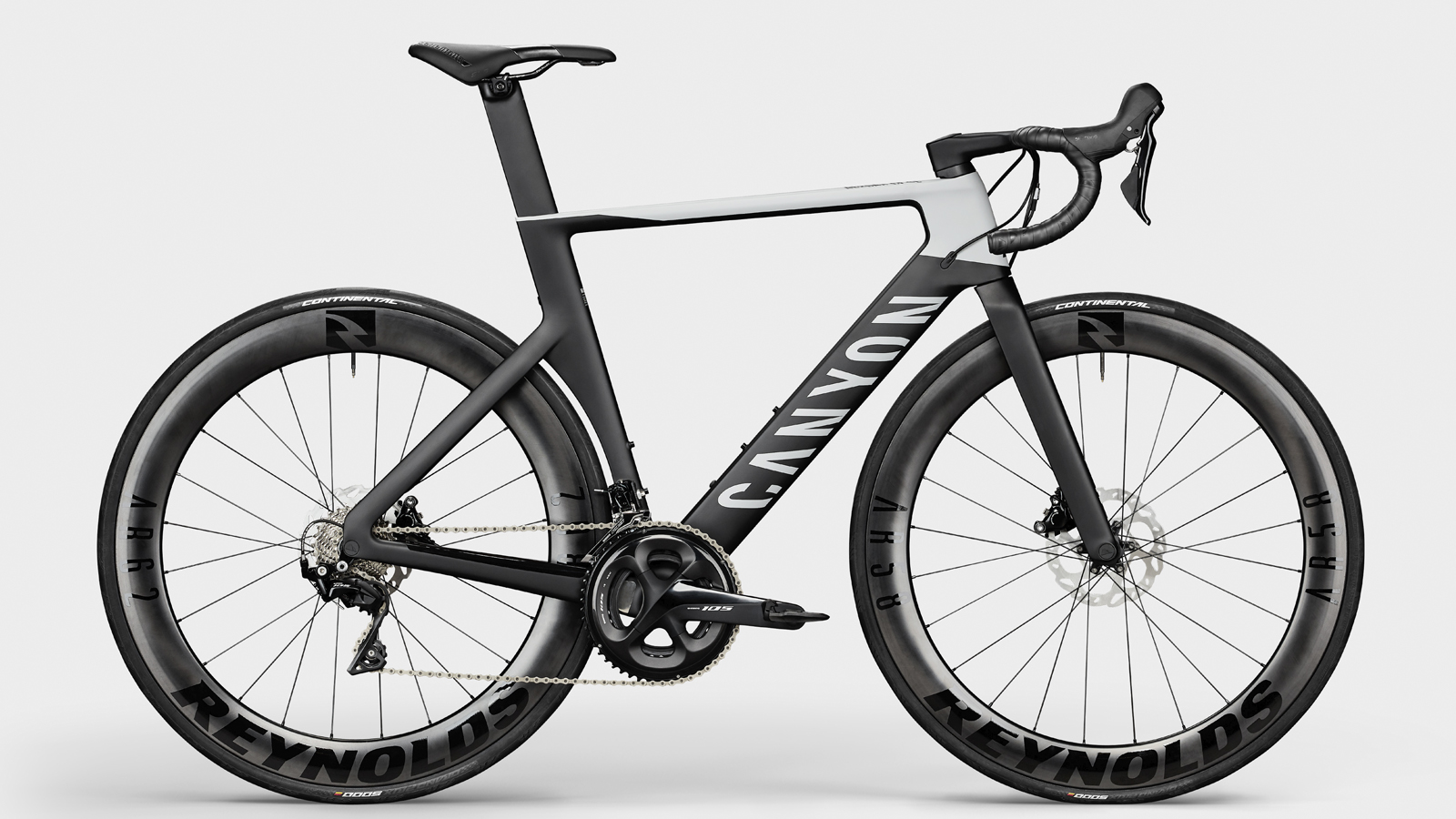Canyon launches new Aeroad for 2021
The long-awaited new Canyon Aeroad becomes an integrated, lightweight aero all-rounder with quill stem and more relaxed geometry

Canyon has finally announced the launch of the new Canyon Aeroad, more than a year since a prototype appeared beneath Mathieu Van der Poel ahead of the 2019 UCI Road World Championships.
On first impressions, the design is very much in keeping with the modern trend of combining aerodynamics and reduced weight. It features an integrated cockpit, wider tyre clearances and a commitment to disc brakes.
However, there are a few additional quirks that make the Aeroad stand out against its rivals in the best road bikes competition, such as adjustable handlebar width, cut-free stem height adjustability, odd tyre sizes, a more relaxed geometry, and the return of 650b wheels on the smallest sizes.
According to Canyon, the resulting bike is 7.4 watts faster, 168 grams lighter and 14 per-cent stiffer than its predecessor, and the early impressions in our 2021 Canyon Aeroad review are very positive.
New Canyon Aeroad
The range will comprise eight models across three platforms. At the lower end of the range sits the Aeroad CF SL, a bike that will feature mechanical shifting, the same externally routed cockpit as the former Aeroad, 650B wheels on the two smallest sizes, and the option of size 3XS.
The Aeroad CF SLX sits in the middle of the range, while the halo model Aeroad CFR is given Canyon's new top tier carbon lay-up. The CF SLX and the CFR both feature 700c wheels across the size run and both use the new CP0018 integrated cockpit.
All three models share the same geometry chart, as well as the new, catchily named SP0046 seatpost, which is deeper, but features a narrowed section inside the frame for reduced weight and added compliance.
The latest race content, interviews, features, reviews and expert buying guides, direct to your inbox!
An aero all-rounder

With help from CFD software and aerodynamics experts at Swiss Side, Canyon performed more than seven times as much CFD analysis than for the outgoing Aeroad in order to not only maximise efficiency at zero degrees yaw, but to harness the sailing effect in crosswinds.
In wind tunnel testing performed by German magazine, Tour (which Canyon uses to benchmark its performance), the original Aeroad long stood as the fastest bike available. While a few have tested better over recent years, it is still measured among the best. However, the new Aeroad is said to be 7.4 watts faster, putting Canyon back into the number one spot once again.
Meanwhile, by breaking the bike down to its individual components and shaving weight from each, the new Aeroad CFR sees a weight reduction of 168 grams as well as a 14-per cent gain in stiffness.
| COMPONENT | R065 AEROAD CFR | R050 AEROAD CF SLX |
|---|---|---|
| FRAME | 915g | 1010g |
| FORK | 425g | 445g |
| COCKPIT | 375g | 412g |
| SEATPOST | 180g | 186g |
| SMALL PARTS | 55g | 65g |
| TOTAL | 1950g | 2118g |
This improvement is compounded by Alejandro Valverde's decision to use the new Aeroad for every stage of this year's Tour de France, including high mountain stages and the latter part of the stage 20 time trial.
Cyclingnews' size L test model weighs in at 7.3kg, complete with deep-section clincher wheels and bottle cages. With tubular wheels, it can be feasible that Valverde's Aeroad hits 6.8kg without issue.
A different approach to cockpit integration
Due to Canyon's direct to consumer approach and subsequent courier delivery of its bikes, Canyon sought a solution that would enable all customers to assemble the bike's integrated cockpit without risk of damage.

The result is Canyon's new CP0018 aerocockpit, on which the handlebars can be split at the tops without cables being removed. The outer portion of the handlebar (drops, hoods, shifters and a portion of the tops) then slides onto the central section and is secured using two hex bolts. This not only improves the safety of the bike during its inaugural journey, but also simplifies things when the owner wishes to travel with their bike in future.
What's more, with this approach, the handlebar can also be adjusted between three widths, which range in 20mm increments from 370mm to 450mm depending on the frame size. The cabling does run internally, though, so if you want a shorter/longer stem down the line, it will require disassembly of cables. Although because the handlebars split at the tops, the shifters can remain in situ and the same drops fitted to the new centre section.
Canyon has also created a modern take on the quill stem which allows a rider to remove spacers from beneath the stem without needing to cut the steerer tube. Thanks to the popularity of integrated cockpits, many modern bikes forego the traditional stem, spacer and top cap design, so to try out a lower position, the steerer tube often needs to be cut, which in turn, means that a rider can't then go back to the former higher position.
Canyon's quill stem design means the stem is affixed to a 1 1/4in sleeve which slides around the outside of the 1 1/8in steerer tube. This allows for 15mm of height adjustment - in 5mm increments - without the steerer needing to be cut.
The downside to this is that the new Aeroad is limited to Canyon's CP0018 cockpit, which at the time of launch, is only available in limited sizes and a minus six-degree angle. However, CP0015 'pro fit' cockpits - which are angled at minus 17 degrees - are soon to be made available.

Comfort is key
The overarching task for Canyon engineers was to make a race bike that is as aerodynamic, light and fast as possible. However, Canyon also understands that aero affects everyone, not just pro riders racing at 45kph.
Therefore, Canyon relaxed the geometry of the aggressively-positioned Aeroad CF SLX, increasing the stack by 9mm and shortening the reach by 5mm. This results in a riding position that mirrors the 'Sport Pro' geometry of the brand's Ultimate lightweight race bike.
2021 Canyon Aeroad specs and prices
Here is every new bike in the 2021 Canyon Aeroad range including images, specs and international pricing. Not all colourways are pictured below.
The new Aeroad is available to order immediately via Canyon.com, or to read our early impressions on the bike, check out our 2021 Canyon Aeroad review.
Aeroad CFR Di2


- Price: €7,499 / £7,699 / $7,599 / AU$11,749
- Frame: CFR
- Groupset: Shimano Dura-Ace Di2 power meter
- Wheels: DT Swiss ARC1100 Dicut 62
- Cockpit: CP0018
Aeroad CFR eTap

- Price: €7,999 / £8,199 / $8,099 / AU$12,549
- Frame: CFR
- Groupset: SRAM Red eTap AXS power meter
- Wheels: DT Swiss ARC1100 Dicut 62
- Cockpit: CP0018
Aeroad CFR EPS

- Price: €8,999 / £9,299 / $9,099 / AU$14,099
- Frame: CFR
- Groupset: Campagnolo Super Record EPS
- Wheels: Campagnolo Bora One 50
- Cockpit: CP0018
Aeroad CFR Frameset


- Price: €4,299 / £4,499 / $4,349 / AU$6,749
- Frame: CFR
- Cockpit: CP0018
Aeroad CF SLX 8 Di2



- Price: €4,999 / £5,199 / $5,049 / AU$7,849
- Frame: CF SLX
- Groupset: Shimano Ultegra Di2
- Wheels: DT Swiss ARC1400 Dicut 62
- Cockpit: CP0018
Aeroad CF SLX 8 eTap


- Price: €5,299 / £5,499 / $5,349 / AU$8,299
- Frame: CF SLX
- Groupset: SRAM Force eTap AXS
- Wheels: DT Swiss ARC1400 Dicut 62
- Cockpit: CP0018
Aeroad CF SL 8


- Price: €3,699 / £3,799 / $3,749 / AU$5,799
- Frame: CF SL
- Groupset: Shimano Ultegra
- Wheels: Reynolds AR 58/62
- Cockpit: CP10
Aeroad CF SL 8 Women's

- Price: €3,699 / £3,799 / $3,749 / AU$5,799
- Frame: CF SL
- Groupset: Shimano Ultegra
- Wheels: Reynolds AR 58/62
- Cockpit: CP10
Aeroad CF SL 7


- Price: €3,299 / £3,399 / $3,349 / AU$5,149
- Frame: CF SL
- Groupset: Shimano 105
- Wheels: Reynolds AR 58/62
- Cockpit: CP10

Josh is Associate Editor of Cyclingnews – leading our content on the best bikes, kit and the latest breaking tech stories from the pro peloton. He has been with us since the summer of 2019 and throughout that time he's covered everything from buyer's guides and deals to the latest tech news and reviews.
On the bike, Josh has been riding and racing for over 15 years. He started out racing cross country in his teens back when 26-inch wheels and triple chainsets were still mainstream, but he found favour in road racing in his early 20s, racing at a local and national level for Somerset-based Team Tor 2000. These days he rides indoors for convenience and fitness, and outdoors for fun on road, gravel, 'cross and cross-country bikes, the latter usually with his two dogs in tow.